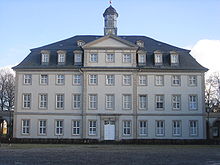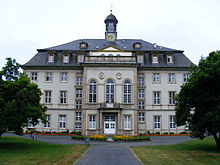Wabern hunting lodge
The former hunting lodge Wabern is located on the northwestern outskirts of Wabern in the Schwalm-Eder district in northern Hesse .
history
The three-storey baroque main building of the hunting lodge was built from 1704 to 1707 by Landgrave Karl von Hessen-Kassel for his wife Maria Anna Amalia von Kurland in the wide plain between the rivers Eder and Schwalm , based on designs by the court architect Johann Konrad Giesler . The marshy subsoil on the edge of the Ederaue was drained for the construction and supported with driven piles. A central projection was created on the park side , which was closed off by a balcony. This was decorated with medallions with relief heads of the landgrave and his wife. Landgrave Friedrich II had the side buildings connected to the main building by galleries built around 1770 by the builder Simon Louis du Ry , completing the expansion of the now horseshoe-shaped complex.
The philosopher Voltaire was on 27. – 29. May 1753, when he fell out of favor with King Friedrich II in Potsdam and traveled back to France, guest of Landgrave Wilhelm VIII and his son Friedrich in Wabern. Knigge visited the castle on January 14, 1770. On September 16, 1779, Goethe traveled from Kassel to Wabern.
After the death of Landgrave Friedrich II. In 1785, the castle was not used for a long time and fell into disrepair. Only Elector Wilhelm II repaired the palace and park in the 1820s and furnished it with 500 oil paintings and 1200 copperplate engravings. The collection largely consisted of works by the Tischbein family of painters . The motifs included depictions of the castle from its heyday, portraits of its owners, scenes of heron hunting and images of particularly valuable falcons . Important parts of the collection are now in the Fasanerie Castle in Fulda . In particular, the pictures of the heron hunt are highlights of the collection in Fulda. The wall-sized baroque paintings of the heron stain were created by Johann Heinrich Tischbein the Elder (1722–1789).
park
The former royal stables are located in the adjacent park. It dates from the 18th century. In 2007 it was converted into a school building, as was the former director's residence. The park was created with native and foreign plants, but is no longer preserved in its original form.
Heron hunting in the heron forest
Glorious Rococo festivals were celebrated under Landgrave Friedrich II . Friedrich ran a falconry in Wabern . Every year in June he held a court camp in Wabern, where he pursued his passion for hunting. The most popular hunting pleasure was the hunt for herons in the nearby " Heron Forest" on the Schwalm, where numerous heron nests were located and a large colony of birds lived. All employees from the falconry were relocated from Waldau near Kassel to Wabern for the hunt with falcons.
Todays use
With the annexation of the Electorate of Hesse by Prussia in 1866, Wabern also became Prussian possession, although the question of the future use of the palace was initially unresolved. During the Franco-Prussian War of 1870/71 , Elisabeth Deichmann-Schaaffhausen headed a hospital in the castle for a few months .
In the years 1885 to 1886 the Prussian state set up a “compulsory education institution for male pupils” in the now unnamed “Karlshof” building complex. In 1927 the local authority in Kassel took over the institution. In 1953 the State Welfare Association became a maintenance provider, and the former castle was now called the “State Youth Home Karlshof”.
Today the castle is used by the "Vitos Kurhessen gGmbH" (previously: Center for Social Psychiatry) in Merxhausen as the location of "Station 4" and an outpatient department for child and adolescent psychiatry in Kassel. "Vitos Kalmenhof gGmbH" in Idstein uses one floor and the north wing for inpatient youth welfare. The former stables and the director's residence in the park now belong to the Schlossberg School, a special school for educational assistance and the sick. The previous training workshops for young people were closed on July 1, 2012. The Vitos companies and the Schlossberg School belong to the State Welfare Association of Hesse.
In his detective novel Schmuddelkinder , published in 2010, the Kassel-based writer Matthias P. Gibert processes his experiences as a child in the Karlshof.
Footnotes
literature
- Rolf Müller (Ed.): Palaces, castles, old walls. Published by the Hessendienst der Staatskanzlei, Wiesbaden 1990, ISBN 3-89214-017-0 , pp. 351f.
Web links
Coordinates: 51 ° 6 ′ 17 ″ N , 9 ° 20 ′ 30 ″ E



